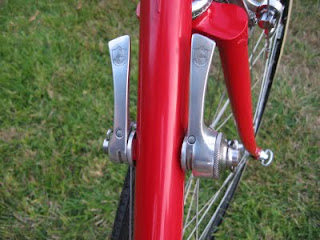
From a Classic and Vintage forum "Tipo's were second tier, by 1982, paired with the Nuovo Gran Sport group. For a short time in the early 60's there was also a Sport hub from Campagnolo, not many of those around. Now, the cones on Tipos are close, but not the same as Record. But the cups pressed into the hubs are VERY different. Record gets the ground and heat treated units, Tipo does not. The outside diameter of the Record cup is larger than the Tipo. Long ago, I had the idea to "recordize" my Tipos, no go. The lock nut design and spacers are also different. Can't even exchange dust caps.
Many, but not all Campagnolo hub cones are date coded, if you take them apart to examine the mating surface. Tipo's can be as smooth as Record hubs in feel of the bearings, but for the very long term are not as durable. Tipo's are probably as good as most other competing brands top line wares long ago, with the exception of " Dura-Ace.
What is also great is these hubs are available in good-great condition for less than $50 @ set. I then needed a set of rims to go with the hubs. My initial idea was to use Sun M13II rims which have the old Mavic MA series box section rim look.


The problem with these rims is they are very common, so I continued to look. I eventually came across the Velo Orange PBP rim.
 Velo Orange describes these rims as follows. For years cyclists have been lamenting the loss of the simple box section rim in a shiny silver polished finish. So Velo Orange has worked with one of the premier rim companies in Taiwan to find a replacement. We researched different widths, shapes, and materials, and what was being currently sold. It quickly became apparent that we needed to offer an alloy doublewall rim. Doublewall construction adds a bit of weight as compared to singlewall (or open box) rims, but we feel a classic doublewall box design is far superior in terms of overall strength, load capacity, and impact resistance, particularly with modern aluminum alloys.
Velo Orange describes these rims as follows. For years cyclists have been lamenting the loss of the simple box section rim in a shiny silver polished finish. So Velo Orange has worked with one of the premier rim companies in Taiwan to find a replacement. We researched different widths, shapes, and materials, and what was being currently sold. It quickly became apparent that we needed to offer an alloy doublewall rim. Doublewall construction adds a bit of weight as compared to singlewall (or open box) rims, but we feel a classic doublewall box design is far superior in terms of overall strength, load capacity, and impact resistance, particularly with modern aluminum alloys. The two rims are similar enough that some have suggested that the PBP is simply a re-branded M13II. This simply not the case; first the PBP is made in Taiwan and all Sun rims are made in China (hence the PBP is twice as expensive). Like many of the parts the PBP is also polished to a high gloss.
Once you get a hub and rim, you need to determine the spoke lengths you are going to use; this is usually accomplished with a spoke calculator. The one I use is very simple but accurate; http://lenni.info/edd/. If the hub and rim are in the data base, all the measurements have already been done. If not you need the to measure the rim and hub to figure spoke lengths. If not there are directions on the site on how to take the measurements. One measurements that is necessary is the rim Effective Rim Diameter or ERD. This is simply the interior diameter of the rim plus the additional length needed to thread a spoke through nipple on both sides; this usually adds 5-6mm to the ERD; The PBP rims have an ERD of 606mm.


To measure the hub, you need to know the flange spoke hole diameter (both sides as some are different); the measurement from the left and right flange to the center line and the spoke hole diameter. With front wheels and most track or single speed hubs the flange to center line will either be the same or close enough to not matter much. With hubs made for gear clusters, the spokes on the right will be shorter, as the wheel will be dished to accommodate the gear cluster. These are the measurements I used.
Campagnolo Nuovo Tipo (small flange), front
Hub Measurements
| Left flange diameter | 39.0 mm |
| Right flange diameter | 39.0 mm |
| Centre to right flange | 35.0 mm |
| Centre to left flange | 35.0 mm |
| Spoke hole diameter | 2.5 mm |
Campagnolo Nuovo Tipo (small flange), rear
Hub measurements
Front hub| Left flange diameter | 44.0 mm |
| Right flange diameter | 44.0 mm |
| Centre to right flange | 20.0 mm |
| Centre to left flange | 37.0 mm |
| Spoke hole diameter | 2.5 mm |
Plugging this info into the calculator you get two lengths for each wheel. For the front wheel they are the same; 294.6 mm Since it is always best to round up I used 295 mm spokes.
For the rear there are two sizes, 293.7 mm for the left and 292.1 mm for the right; I rounded the left to 294 mm and right 292 mm.
Building a wheel is a post or book unto itself. So I say for now that I laced up the wheels and this is how they looked.










































